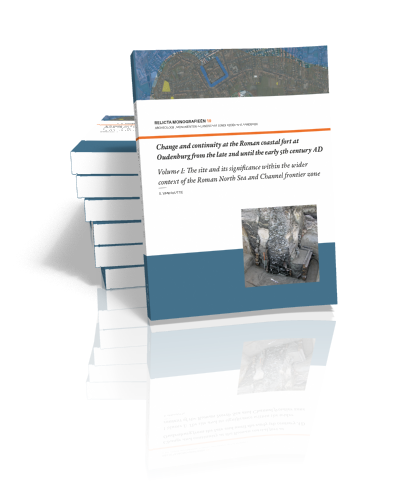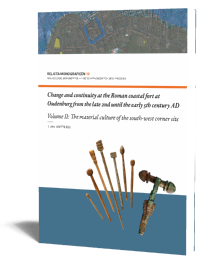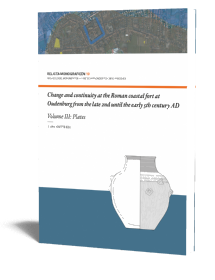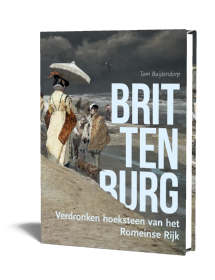Change and continuity at the Roman coastal fort at Oudenburg from the late 2nd until the early 5th century AD (Volume I)
The site and its significance within the wider context of the Roman North Sea and Channel frontier zone
S. Vanhoutte | 2023

Change and continuity at the Roman coastal fort at Oudenburg from the late 2nd until the early 5th century AD (Volume I)
The site and its significance within the wider context of the Roman North Sea and Channel frontier zone
S. Vanhoutte | 2023
Paperback ISBN: 9789464260830 | Hardback ISBN: 9789464260847 | Imprint: Sidestone Press | Format: 210x280mm | 320 pp. | Relicta Monografieën 19 | Language: English | 7 illus. (bw) | 115 illus. (fc) | Keywords: Roman archaeology; Roman forts; Roman military; Roman defence structures; Roman material culture | download cover | DOI: 10.59641/f5a870e7
Read online 467 times
- Digital & Online access
-
Buy via Sidestone (EU & UK)
-
Buy via our Distributors (WORLD)
For non-EU or UK destinations you can buy our books via our international distributors. Although prices may vary this will ensure speedy delivery and reduction in shipping costs or import tax. But you can also order with us directly via the module above.
UK international distributor
USA international distributor
-
Bookinfo
Paperback ISBN: 9789464260830 | Hardback ISBN: 9789464260847 | Imprint: Sidestone Press | Format: 210x280mm | 320 pp. | Relicta Monografieën 19 | Language: English | 7 illus. (bw) | 115 illus. (fc) | Keywords: Roman archaeology; Roman forts; Roman military; Roman defence structures; Roman material culture | download cover | DOI: 10.59641/f5a870e7
Read online 467 times

We will plant a tree for each order containing a paperback or hardback book via OneTreePlanted.org.
In the later Roman period the North Sea and Channel region was the scene of seaborne attacks, political crises, army reforms, Germanic invasions and changing imperial defence strategies. Literary evidence for this era is poor. On the other hand the Shore forts can yield highly significant information, but have been subject to little study in recent decades. At the Belgian coastal fort at Oudenburg large-scale excavations in the first decade of the 21st century revealed a strikingly well-preserved chronological, spatial and functional evolution of this military base, with five main fort periods running from the late 2nd until the early 5th century AD. For the first time within the context of the Shore forts securely datable structural evidence demonstrates the stages in progression of a mid- to late Roman fort where the horizons can be related to historically recorded processes and events in the region. Political, economic and social developments can be seen within this evidence, as a result of the assessment of the huge quantity of well-stratified finds types. Reports on the finds assemblage by specialist experts, using various analytical methods, represent ‘touchstones’ for regional military and later Roman studies in the North-West provinces.
The study of Oudenburg, and in relationship to other Shore forts, enables exploration of ‘change and continuity’ and ‘identity’, in respect of the everyday lives of soldiers, and in their interaction with other forts and wider regional spheres. This is achieved by examining find contexts as reflections of the socio-cultural world. The study of ‘military identities’ is further emphasized through looking at the associated graveyards wherein the direct relationship with the successive fort periods is established. It is clear this fort was closely connected with the British forts and that there occurred an increasing Germanic influence as the fort transformed into a community of military families.
This is volume one of three. This volume provides a detailed analysis of the Oudenburg site and the report of the research of its significance within the wider context of the Roman North Sea and Channel frontier zone, on a historic-military, a socio-cultural and a socio-economic level.
Also see:I. Introduction
I.1. The Roman military along the Channel: research questions and how the Oudenburg research can contribute to our understanding
I.2. Research methodology and selection of data
I.3. State of the art of the Roman military in the Channel region: an overview of the wider military context of the Oudenburg fort
I.4. Historiography of the fort site of Oudenburg
I.5. The general chronological framework of the fort site as outlined by the former research
II. New insights into the stratigraphy, morphology and site formation processes at the Oudenburg fort
II.1. Introduction to the stratigraphy and morphology research of the site
II.2. The stratigraphy of the site: the study of the trench profiles
II.3. The evolution of the defence system
II.4. The inner building: occupation levels and their relation to the defence system
II.5. Site formation processes: the evidence from the spatial distribution of material, residuality and rubbish disposal, and the value of the find assemblages
III. The successive forts at Oudenburg in a changing landscape
III.1. Decisive factors for the fort’s history: the marine influence and the pauvrity in hard natural rock
III.2. The landscape at the time of the installation of the first fort
III.3. The landscape in the 3rd century AD
III.4. The landscape in the late Roman period i.e. the 4th century and later
III.5. Conclusion: a changing landscape around the Oudenburg fort
IV. The successive forts at Oudenburg and their related graveyards
IV.1. Introduction
IV.2. The mid-Roman graveyards
IV.3. The late Roman graveyards
IV.4. Conclusion: relationship between the successive forts and their graveyards
V. Confronting stratigraphy and material culture to come to new insights into the fort’s occupation and the wider context
V.1. A refined fort chronology for the Oudenburg castellum, its significance for the historic setting of the fort and within the wider historic context of the Channel region
V.2. Continuity and change in supply, trade and exchange networks towards the Oudenburg fort and in the Channel region
V.3. Material culture and ‘military’ identities
VI. Conclusions. Change and continuity: the Oudenburg fort reflecting later Roman military development along the North Sea and Channel frontier zone
VI.1. The Roman fort at Oudenburg as a key site for the Roman North Sea and Channel frontier zone
VI.2. A contribution on a historic-military level
VI.3. A contribution to the reconstruction of socio-cultural identities
VI.4. A contribution on a socio-economic level
VI.5. A contribution on a methodological level
APPENDIX 1. Overview of the archaeological observations at Oudenburg yielding information on the Roman character of the sand ridge
APPENDIX 2. Trenches of J. Mertens in the 1950s, 1960 and 1970s on the defence area of the Oudenburg fort. Summaries
APPENDIX 3. Features identified in the 1957 trenches VI–VIa–VIb. Interpretation of the descriptions by J. Mertens
APPENDIX 4. Analysis of trench profiles at the south-west corner site of the Oudenburg fort
APPENDIX 5. The hearths of fort level 4 at the south-west corner site of the Oudenburg fort
APPENDIX 6. Absolute chronological data available for the south-west corner site of the Oudenburg fort
APPENDIX 7. Oudenburg Graveyard A. Overview of the burials, their characteristics and content
APPENDIX 8. Oudenburg Graveyard C. Overview of the burials, their characteristics and content
BIBLIOGRAPHY

Dr. S. Vanhoutte
Sofie Vanhoutte is Heritage Researcher Archaeology at the Flanders Heritage Agency (Belgium). Since 2019 she is also teaching assistant at Ghent University. This publication is a further enlargement of her doctoral research ‘Change and Continuity at the Roman Fort at Oudenburg from the late 2nd until the early 5th century AD, with a particular focus on the evidence of the material culture and its significance within the wider context of the Roman North Sea and Channel frontier zone’, a joint PhD at the Free University of Brussels (VUB) and the University of Kent (Canterbury, UK). She defended her PhD successfully in September 2018.
Abstract:
In the later Roman period the North Sea and Channel region was the scene of seaborne attacks, political crises, army reforms, Germanic invasions and changing imperial defence strategies. Literary evidence for this era is poor. On the other hand the Shore forts can yield highly significant information, but have been subject to little study in recent decades. At the Belgian coastal fort at Oudenburg large-scale excavations in the first decade of the 21st century revealed a strikingly well-preserved chronological, spatial and functional evolution of this military base, with five main fort periods running from the late 2nd until the early 5th century AD. For the first time within the context of the Shore forts securely datable structural evidence demonstrates the stages in progression of a mid- to late Roman fort where the horizons can be related to historically recorded processes and events in the region. Political, economic and social developments can be seen within this evidence, as a result of the assessment of the huge quantity of well-stratified finds types. Reports on the finds assemblage by specialist experts, using various analytical methods, represent ‘touchstones’ for regional military and later Roman studies in the North-West provinces.
The study of Oudenburg, and in relationship to other Shore forts, enables exploration of ‘change and continuity’ and ‘identity’, in respect of the everyday lives of soldiers, and in their interaction with other forts and wider regional spheres. This is achieved by examining find contexts as reflections of the socio-cultural world. The study of ‘military identities’ is further emphasized through looking at the associated graveyards wherein the direct relationship with the successive fort periods is established. It is clear this fort was closely connected with the British forts and that there occurred an increasing Germanic influence as the fort transformed into a community of military families.
This is volume one of three. This volume provides a detailed analysis of the Oudenburg site and the report of the research of its significance within the wider context of the Roman North Sea and Channel frontier zone, on a historic-military, a socio-cultural and a socio-economic level.
Also see:- Change and continuity at the Roman coastal fort at Oudenburg Volume 2
- Change and continuity at the Roman coastal fort at Oudenburg Volume 3
Contents
I. Introduction
I.1. The Roman military along the Channel: research questions and how the Oudenburg research can contribute to our understanding
I.2. Research methodology and selection of data
I.3. State of the art of the Roman military in the Channel region: an overview of the wider military context of the Oudenburg fort
I.4. Historiography of the fort site of Oudenburg
I.5. The general chronological framework of the fort site as outlined by the former research
II. New insights into the stratigraphy, morphology and site formation processes at the Oudenburg fort
II.1. Introduction to the stratigraphy and morphology research of the site
II.2. The stratigraphy of the site: the study of the trench profiles
II.3. The evolution of the defence system
II.4. The inner building: occupation levels and their relation to the defence system
II.5. Site formation processes: the evidence from the spatial distribution of material, residuality and rubbish disposal, and the value of the find assemblages
III. The successive forts at Oudenburg in a changing landscape
III.1. Decisive factors for the fort’s history: the marine influence and the pauvrity in hard natural rock
III.2. The landscape at the time of the installation of the first fort
III.3. The landscape in the 3rd century AD
III.4. The landscape in the late Roman period i.e. the 4th century and later
III.5. Conclusion: a changing landscape around the Oudenburg fort
IV. The successive forts at Oudenburg and their related graveyards
IV.1. Introduction
IV.2. The mid-Roman graveyards
IV.3. The late Roman graveyards
IV.4. Conclusion: relationship between the successive forts and their graveyards
V. Confronting stratigraphy and material culture to come to new insights into the fort’s occupation and the wider context
V.1. A refined fort chronology for the Oudenburg castellum, its significance for the historic setting of the fort and within the wider historic context of the Channel region
V.2. Continuity and change in supply, trade and exchange networks towards the Oudenburg fort and in the Channel region
V.3. Material culture and ‘military’ identities
VI. Conclusions. Change and continuity: the Oudenburg fort reflecting later Roman military development along the North Sea and Channel frontier zone
VI.1. The Roman fort at Oudenburg as a key site for the Roman North Sea and Channel frontier zone
VI.2. A contribution on a historic-military level
VI.3. A contribution to the reconstruction of socio-cultural identities
VI.4. A contribution on a socio-economic level
VI.5. A contribution on a methodological level
APPENDIX 1. Overview of the archaeological observations at Oudenburg yielding information on the Roman character of the sand ridge
APPENDIX 2. Trenches of J. Mertens in the 1950s, 1960 and 1970s on the defence area of the Oudenburg fort. Summaries
APPENDIX 3. Features identified in the 1957 trenches VI–VIa–VIb. Interpretation of the descriptions by J. Mertens
APPENDIX 4. Analysis of trench profiles at the south-west corner site of the Oudenburg fort
APPENDIX 5. The hearths of fort level 4 at the south-west corner site of the Oudenburg fort
APPENDIX 6. Absolute chronological data available for the south-west corner site of the Oudenburg fort
APPENDIX 7. Oudenburg Graveyard A. Overview of the burials, their characteristics and content
APPENDIX 8. Oudenburg Graveyard C. Overview of the burials, their characteristics and content
BIBLIOGRAPHY

Dr. S. Vanhoutte
Sofie Vanhoutte is Heritage Researcher Archaeology at the Flanders Heritage Agency (Belgium). Since 2019 she is also teaching assistant at Ghent University. This publication is a further enlargement of her doctoral research ‘Change and Continuity at the Roman Fort at Oudenburg from the late 2nd until the early 5th century AD, with a particular focus on the evidence of the material culture and its significance within the wider context of the Roman North Sea and Channel frontier zone’, a joint PhD at the Free University of Brussels (VUB) and the University of Kent (Canterbury, UK). She defended her PhD successfully in September 2018.
- Digital & Online access
-
Buy via Sidestone (EU & UK)
-
Buy via our Distributors (WORLD)
For non-EU or UK destinations you can buy our books via our international distributors. Although prices may vary this will ensure speedy delivery and reduction in shipping costs or import tax. But you can also order with us directly via the module above.
UK international distributor
USA international distributor
- Browse all books by subject
-
Search all books

We will plant a tree for each order containing a paperback or hardback book via OneTreePlanted.org.
You might also like:
© 2025 Sidestone Press KvK nr. 28114891 Privacy policy Sidestone Newsletter Terms and Conditions (Dutch)








